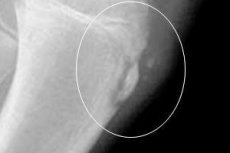Osteochondropathy in children
Last reviewed: 23.04.2024

All iLive content is medically reviewed or fact checked to ensure as much factual accuracy as possible.
We have strict sourcing guidelines and only link to reputable media sites, academic research institutions and, whenever possible, medically peer reviewed studies. Note that the numbers in parentheses ([1], [2], etc.) are clickable links to these studies.
If you feel that any of our content is inaccurate, out-of-date, or otherwise questionable, please select it and press Ctrl + Enter.

Causes of the osteochondropathy in a child
The pathogenesis of the pathological process is based on the violation of the local blood circulation and the feeding of the bone tissue. Because of this, aseptic necrosis develops in the area of spongy substance with its further resorption and recovery. A painful condition develops due to such factors:
- Sympathetic innervation of blood vessels.
- Injuries.
- Increased exercise on certain areas of the bone.
- Genetic predisposition.
- Infectious and inflammatory diseases.
- Congenital malformations of the skeleton and bone system.
- Age and hormonal changes.
- Incorrect shoe size.
Symptoms of the osteochondropathy in a child
In most cases, the disorder is unilateral. The degenerative-dystrophic process in bones has several types that differ in their localization. Children are most often diagnosed with these types of lesions:
- The head of the femur.
- Scaphoid foot bone.
- Tibia.
- Knee joint and patella.
- Heel bone.
- Spine (progressive kyphosis).
- Heads of metatarsal bones.
In addition to the above violations, the medical practice includes chondropathy of the lunate bone, damage to the ribs, sternum, condyle of the femur, talus and others.
Juvenile osteochondropathy
Degenerative-dystrophic processes in the bones of patients of adolescence aged 15-18 are less common than in children and adolescents. In this age group, the lesion of the sternal and lumbar spine (kyphosis), necrosis of the knee joints and hip bone are most often diagnosed.
Osteochondropathy of the vertebral division is associated with the growth features of the thoracic vertebrae, which lag behind the general maturation of the body. Thoracic vertebrae are deformed, which leads to a change in the position of the spine and chest. Because of this, slouching and scoliosis develops. The disease of the bones and joints of the lower limbs is most often associated with injuries and exhausting physical exertion. Necrosis is characteristic of young people who are professionally involved in sports.
Diagnosis consists of instrumental methods. The treatment is aimed at restoring the normal structure of the affected tissue. To do this, use drugs, physiotherapy, exercise therapy, immobilization of the affected limbs, wearing special corrective corsets and more.
Osteochondropathy in adolescents
Aseptic necrosis is most often diagnosed in children and adolescents. The age of 11-15 years is a period of hormonal changes in the body and active growth of the skeleton. Degenerative-necrotic processes in bone tissue in adolescents arise due to the following reasons and factors:
- Hereditary predisposition
- Endocrine and hormonal disorders.
- Disruption of the metabolism of essential substances.
- Traumatic injuries.
- Excessive exercise.
All types of the disease are characterized by slow development and blurred symptoms in the initial stages. As it progresses, there are increasing and sharp pains when moving in the joint of the affected limb, swelling appears, movements can be difficult.
Diagnosis of the disease is based on collecting anamnesis and studying clinical symptoms. Special attention is paid to instrumental research methods. Treatment depends on the stage at which the disease was diagnosed. Therapy is usually conservative. In severe cases, it is possible to conduct surgery to restore normal functioning of the affected limb.
Stages
In its development, the disease goes through five stages. In the early stages, signs of aseptic necrosis are blurred, therefore, it is difficult to recognize it and begin treatment. As the disease progresses, these symptoms appear:
- Pain in the affected area.
- Muscular atrophy.
- Claudication and crunch in the joints.
- Restriction of motor functions.
- Swelling and swelling of tissues.

Treatment of the osteochondropathy in a child
The orthopedic surgeon treats. The doctor is developing a recovery program. Therapy begins with medication, whose action is aimed at improving blood circulation, stimulating the growth of bone tissue and improving the protective properties of the immune system. Also conducted physiotherapy, accelerating regenerative processes. In severe cases and in the presence of complications, surgical intervention is indicated.

